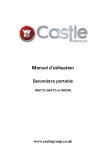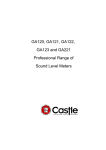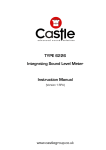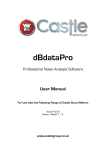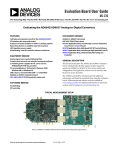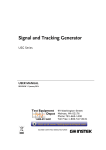Download New Pocket meters manual.pub
Transcript
Notes: Warranty and After Sales Service Thank you for buying a Castle product, I am sure you will find both the goods and the service to be of the highest quality but if not, then please feel free to write to me personally and I will ensure that your needs are dealt with immediately. This manual is designed to show you the operation of the goods you have purchased and a very brief insight into acoustics itself. If you would like to become a competent person in the eyes of the law, then you may like to know more about our Competent persons training course for the Noise at Work Regulations. Castle Group Ltd design and manufacture precision instruments, which if treated with reasonable care and attention should provide many years of trouble free service. In the event of a fault occurring, during the warranty period, the instrument should be returned to Castle Group Ltd, in its original packaging, or to an authorised agent. Please enclose a clear description of the fault or symptom. Details of the warranty cover are available from Castle Group Ltd or an authorised agent. It is my intention for Castle Group Ltd to provide a complete range of Noise and Vibration products and Services of the highest standard. If you would like to know more about any of our other products and services then please complete the reply paid card and return it to us for prompt action or telephone on +44(0)1723 584250. All instruments are designed to meet rigid British and International Standards. An annual calibration is recommended to ensure that these high standards are maintained. This is particularly important for cases in which instrument readings are to be used in litigation or compliance work. Simon Bull For warranty and service return to: The Service Department Castle Group Ltd Salter Road Cayton Low Road Industrial Estate Scarborough North Yorkshire YO11 3UZ Sales and Marketing Director Telephone Fax web +44 (0)1723 584250 +44 (0)1723 583728 www.castlegroup.co.uk Any misuse or unauthorised repairs will invalidate the warranty. Damage caused by faulty or leaking batteries is not covered by the warranty. 19 Case Reflections of the popular range using the Aco 7052 microphone: Stalk length 75mm from front of microphone grid to top of case body. PRECAUTIONS • • • Frequency (Hz) Case Effect (dB) Frequency (Hz) Case Effect (dB) 31.5 0.0 800 0.2 40 0.0 1000 0.0 50 0.0 1250 -0.3 63 0.0 1600 -0.2 • 80 0.0 2000 -0.5 • 100 0.0 2500 0.4 125 0.0 3150 -0.2 160 0.0 4000 -0.1 200 0.0 5000 0.1 250 0.1 6300 0.1 315 0.1 8000 0.0 400 0.1 10000 0.0 500 0.1 12500 -0.2 630 0.1 16000 0.0 18 • • • • • Only operate the instruments as described in this manual. These are precision instruments, protect from shocks and vibrations. Take special care with the microphone. The diaphragm is made from a very thin metal and is easily damaged. Ambient conditions for the operation of the unit are as follows:Temperature -10°C to +50°C Relative Humidity 30 to 90% Protect the unit from dust, water, extremes of temperature and humidity, direct sunlight and air with a high salt or sulphur content. Always turn the unit off after use. Remove the battery from the instrument if it is not to be used for an extended period (several days). Do not use any solvents or cleaning agents on the instrument. Use only a soft dry cloth or a soft cloth lightly moistened with water when necessary. Do not let any conductive objects, such as wire of metal scraps get into the unit. Do not try to disassemble the instrument or attempt any repairs as this may invalidate your warranty. Take a note of the condition of the instrument and contact your authorised Castle service station. To ensure continued precision performance of your instrument have it checked and serviced at regular intervals. Effect of Temperature: TITLE CONTENTS PAGE NO Accuracy better than ± 0.5 dB over the range -10 to +50°C when corrected as indicated here: The temperature correction to be applied for GA601 / GA607 and microphone: KEYPAD LAYOUT 1 Corrected level = Actual level – 0.05(t-20) INTRODUCTION 2 Where t is the temperature in °C USING THE MANUAL 2 BATTERY INSTALLATION 3 THE MICROPHONE 3 SWITCHING ON AND OFF 4 ACTIVATING BUTTONS 4 CALIBRATION 5 DISPLAYING PARAMETERS 6 LOCKING THE INSTRUMENT 8 CONTRAST CONTROL 8 PAUSING/ PLAYING 8 RESETTING PARAMETERS 9 CHANGING RANGE 10 FREQUENCY/ TIME WEIGHTING 10 CRITERION/ EXCHANGE 11 INSTRUMENT STATUS 12 Overall Dimensions: TECHNICAL SPECIFICATIONS 13 Dimensions 210mm x 60mm x 35mm (approx.) WARRANTY AND AFTER SALES SERVICE 19 Weight Effects of Humidity: Less than 0.5 dB over the range 25 to 90% relative humidity (provided there is no Condensation), relative to the value at 50% relative humidity and 40°C. Storage range: 0 to 90% relative humidity in the absence of condensation Vibration: Effect From 20Hz to 1kHz at 1ms-2 no noticeable effect Humidity: Effect < 0.5 dB from 30% RH to 90% RH Magnetic Field: Effect No noticeable effect Body in Free Field: Effect No noticeable effect Windshield: Attenuation < 0.2 dB Battery: Life: 1x MN1604 (size PP3) alkaline cell 20 hours continuous use (approx) based upon bench tests with procell MN1604 batteries 220g including batteries 17 Crest factor capability: KEYPAD LAYOUT 13 dB at full scale deflection Signal to Noise ratio: > 5 dB at bottom of scale EMC Performance: Radiated emissions to EN 50 081-2 No significant emissions from the instrument Calibration Reference Conditions: 23°C air temperature 50% relative humidity 101.325 kPa atmospheric pressure OK 94.0 dB at 1kHz nominal reference level 55 – 120dB reference range Reference direction of incidence for all microphones perpendicular to the front face (diaphragm surface) of the microphone. UP ARROW DOWN ARROW MENU Detector Characteristics: RMS and Peak CLEAR SCROLLING DISPLAY Warm up time < 10 minutes Operating range -10°C to +50°C STATUS PAUSE/ PLAY Warning: DO NOT subject the instrument to temperatures greater than 70°C or less than -20°C for any length of time. POWER ON/ OFF 1 16 Linear Operating Range: INTRODUCTION GA213/GA215 65dB The GA213, GA215 and GA256 are part of Castle’s “Pocket Range” of meters and have been designed to surpass the requirements of the new international Class 2 sound level meter standards. They may be used in industry or for general purpose measurement to ascertain noise levels accurately yet economically. GA256 67dB This manual contains complete operating instructions for the above named instruments, read it carefully and you will quickly become familiar with your instrument. If you have problems with the operation of the instrument please call Castle Group Ltd on +44 (0)1723 584250 or fax +44 (0)1723 583728. Reference Range: USING THE MANUAL Reference Frequency: In the course of this manual a named button written in BOLD means press that button. E.g. OK means press the OK button. Reference Level: GA208, GA214 GA213/GA215 GA213/GA215 94dB 55 – 120 1kHz Display: Since this manual covers the operating instructions for three instruments the shaded areas of the title serves to inform the user which functions are present on your instrument. Digital 1 x 8 alphanumeric, digit size 7mm x 5mm Liquid Crystal Display E.g. The following title informs you that this function is only applicable to the GA213/215 Microphone: Aco ½ “ Electret Condenser Microphone Cartridge Type 7052 CHANGING RANGE GA213/215 Type Diameter (inch) Response Type Polarisation (V) Frequency Range (Hz) Sensitivity (mV/Pa) Sensitivity (dB re 1V/Pa) Capacitance (pF) Max. Sound Pressure Level (dB) Temperature Coefficient (dB/°C) Specification 0.5 Free-Field 0 20 - 8000 25 -32 18 146 -0.01 2 15 BATTERY INSTALLATION RMS Frequency Weighting: GA213 A and C weightings according to IEC 61672-1 Class 2, IEC60651 GA215 A and C weightings according to IEC 61672-1 Class 2, IEC60651 GA256 Type 2 Type 2 A weighting according to IEC 61672-1 Class 2 GA213 S and F according to IEC 61672-1Class 2, IEC 60651 Type 2 GA215 S and F according to IEC 61672-1Class 2, IEC 60651 Type 2 Level Ranges (dB) GA256 GA213/GA215 To prepare the equipment for use a heavy duty alkaline battery type 6LR61 should be fitted, such as a Procell/Duracell MN1604, Ever Ready 6LF22 Gold Seal, or equivalent. The battery door is located on the bottom left hand side of the instrument. Open the battery door cover by sliding the cover downward towards the bottom of the instrument. The cover will now swing open exposing the battery compartment. Insert the battery observing the correct polarity as marked on the case wall. Close the battery compartment door by reversing the procedure above. The instrument is now ready for calibration and use. Time Weightings: GA213/GA215 All Linear Operating Range (IEC 61672-1 :2002 1kHz) Primary Indicator Range (IEC 60651 : 2001 1kHz) 35 – 100 35 - 93 55 – 120 75 – 140 55 - 113 75 - 133 70 – 137 70 - 130 Peak Hold Display Range Display Range 63 - 103 83 - 123 103 -143 34 – 101 54 – 121 74 – 141 GA256 100 - 140 69 – 141 (Primary Indicator Range allows for a crest factor of 10dB) 14 THE MICROPHONE All The microphone capsule fitted to your instrument is a class 2 instrumentation grade 1/2 inch capsule. The microphone assembly is not removable. The GA256 is fitted with a DOSE meter microphone assembly in order that it can be attached to the collar of a noise exposed worker. WARNING: DO NOT TWIST THE MICROPHONE ASSEMBLY 3 SWITCHING ON AND OFF All TECHNICAL SPECIFICATION Press the POWER button and the instrument name appears. Allow the instrument to scroll through its start-up sequence before pressing any other button, this will take approximately 3 seconds. When the instrument has completed its start-up sequence the display will change to LP (or Lex on GA256) in PAUSED mode using the settings that were last selected. To switch off, press and release the POWER button once and the display goes blank. ACTIVATING BUTTONS All The individual characteristic applies to each instrument unless specifically worded otherwise. Instrument Standards: GA213 IEC 61672-1 : 2002 Class 2 IEC 60651 : 2001 Type 2 EN 60651 : 1994 Type 2 GA215 IEC 61672-1 : 2002 Class 2 IEC 60651 : 2001 Type 2 EN 60651 : 1994 Type 2 IEC 60804 : 2000 Type 2 EN 60804 : 2000 Type 2 GA256 IEC 61252 : 2002 EN 61252 : 1997 Castle instruments operate with an intuitive menu and status system. The menu is selected by using the dedicated buttons on the keypad. A scrolling menu exists within this function, repeated pressing of the buttons will allow you to scroll through the menu. The example below shows the status of the instrument. The displayed messages may vary due to different instrument functions and configurations. ALL Measurement Parameters: Press STATUS BAT 80% Battery status Press STATUS dBA SLOW Frequency & Time weighting selected Press STATUS VER 1.0 Firmware version number Press STATUS WWW.Cast > website (scrolling) GA213 Lp, Lmax, Cpeak, Elapsed time. GA215 Lp, Leq, Lmax, Cpeak, Lex, Elapsed time, SEL. GA256 Pa2h, Lex, DOSE, Projected DOSE, DOHR, Cpeak, Projected Lex, Elapsed time, Peak Frequency Weighting: GA213 C weighting 20Hz to 20kHz to the tolerances of IEC 61672-1 Class 2 Press STATUS RUNNING GA215 C weighting 20Hz to 20kHz to the tolerances of IEC 61672-1 Class 2 GA256 4 C weighting 20Hz to 20kHz 13 INSTRUMENT STATUS All The STATUS menu is therefore circular and can be easily scrolled through by repeated pressing of the STATUS button. Press the DISPLAY button at any time to return to normal operation. The STATUS button is used to display the status of the instrument. Press STATUS This format is repeated for the other functional buttons on your instrument. BAT 80% Repeatedly pressing the STATUS button will scroll through the parameters listed below, depending on the instrument type. BAT.80% Percentage battery capacity remaining ALL dBA SLOW Indicates the current frequency and time weighting VER2.0 Indicates the firmware version number ALL RUNNING Indicates the instrument is running ALL PAUSED Indicates when the instrument is in pause mode (only displayed if instrument is in pause mode) ALL 90/3 Indicates the current criterion and exchange level www. castlegroup.co. uk Scrolling web-site address GA213/215 GA256 ALL CALIBRATION All The calibrators recommended for use are the Castle GA601/607 calibrators, which supply 94dB/ 104dB (relative to 20µPa pressure) at a frequency of 1kHz. Turn the instrument on by pressing the POWER button. Press STATUS to check the battery condition. Replace the battery if the indication is low. Press MENU CAL <OK Press OK and the instrument will now display the previous calibration level e.g. >94.0. The calibration will be performed at the selected level e.g.94.0dB but may be changed in 0.1 dB steps to match the calibrator output by repeated pressing of the UP/DOWN arrow buttons or in 1dB steps by repeated pressing of the STATUS/ PLAY keys. Ensure the calibrator is attached firmly to the microphone. Ensure that the calibrator is set to the chosen level. Press OK and the instrument will calibrate to the level of the calibrator. The display will show SETTLING while calibrating to the chosen level. When calibrated the display will show COMPLETE. Press OK and the display will return to LP for the GA213/215 and DOSE for the GA256. If the input level is not within +/- 3dB of the chosen reference level then the display will show CAL.FAIL. Check to make sure the calibrator is switched on and emitting the correct level before proceeding as indicated above. The instrument is now ready to take measurements. 5 12 DISPLAYING PARAMETERS All The DISPLAY button displays the parameters that are being measured. Repeated pressing of the DISPLAY button scrolls round the parameters listed in the table below. CRITERION/ EXCHANGE GA256 The display will also show the following message when appropriate: ** UR ** when the instrument is Under-range ** OR ** when the instrument is Over-range. (Except GA256 since no range change facility present.) The display will flash when the instrument is Under-range, Over-range or when the Crest factor is being exceeded, indicated by OVERLOAD. You may leave the display menu by pressing any other button. The table shown below lists the display parameters available on each of the Popular Range units as they appear by repeated pressing of the DISPLAY button. GA213 GA215 GA256 Lp (SPL) Lp (SPL) Lex Lmx Leq Plx Pmx Elapsed Time DO % Elapsed Time Lmx Pr % Overload (if triggered) Pmx Mr % Lex Elapsed Time Le Pmx Overload (if triggered) Psq The Criterion and Exchange level can be changed by the use of the MENU button. Press MENU repeatedly until CRIT/EXC Press OK and the instrument will display the options available for CRIT/EXC SETUP. To change the CRIT/EXC use either the up arrow or down arrow button. Pressing either of these two buttons allows you to scroll through the four available criterion and exchange choices, 90/3, 85/3, 90/5, or 85/5. Note: The symbol > indicates the current selection as you move around the criterion/exchange options. Overload (if triggered) The table on the following page is a breakdown of the display parameters and is accompanied by an explanation of each one. 6 is displayed. 11 CHANGING RANGE GA213/215 DISPLAY DESCRIPTION INSTRUMENT 93.7dBC Level Pressure (Lp) LEQ 93.7 Displays the LEQ 00:01:33 Run time duration Lmx 97.3 Maximum Lp The instrument will return to the LP screen. Pmx 98.8 Maximum Peak Note: The symbol > indicates the current selection as you move around the range options. DO % 67 Dose (dependent on exchange and criterion) GA256 Pr % 0 Displays the projected DOSE assuming an 8 hour shift GA256 LEX 87.1 Displays the Lex (Lep’d) GA215 Plx 78.6 Displays the projected Lep’d assuming an 8 hour shift GA256 Le 93.1 Sound Exposure Level (SEL) GA215 Hr% Dose per Hour GA256 Pa2 0.02 Indicates the energy that has been received in Pa2 hours GA256 OVERLOAD Indicates if an OVERLOAD has occurred All —–.— Indicates when values are at 0 e.g. when instrument is first powered on or after a reset in PAUSED mode. All A range change can be performed by the use of the UP/DOWN arrow buttons while in any of the DISPLAY modes (instrument displaying LP dBA etc). Press UP ARROW repeatedly until the required range comes into view, then press OK to select. FREQUENCY/ TIME WEIGHTING GA213/215 A change to the frequency and time weightings can be performed by the use of the MENU button. Press MENU repeatedly until WTG < OK is displayed. Press OK and the instrument will display the options available for WTG SETUP. To change WTG use either the up arrow or down arrow button. Pressing either of these two buttons allows you to scroll through the four available weighting choices, A SLOW, A FAST, C SLOW or C FAST. GA213/215 GA215 All GA215 GA213/256 Note: The symbol > indicates the current selection as you move around the weighting options. 10 7 LOCKING THE INSTRUMENT ALL RESETTING PARAMETERS The LOCK feature is used to lock the instrument keypad. All functions are therefore disabled including the POWER button. The function is often used to avoid inadvertent operation or tampering while the instrument is being used. To LOCK the instrument, press MENU until the instrument displays LOCK then press OK. The status of the battery will be displayed while the instrument is locked. To UNLOCK the instrument press CLEAR, OK then CLEAR respectively. ALL The CLEAR button is used to reset data. Press CLEAR CLEAR? To reset simply press the OK button and following message will be displayed: CONFIRM? CONTRAST CONTROL ALL To change to contrast of the meter press MENU repeatedly until the display shows CONTRAST. Pressing the UP/DOWN arrow buttons will increase and decrease the contrast. When the desired contrast is reached, press the DISPLAY button to return to LP mode. PAUSING/ PLAYING Press PAUSE/ PLAY once Press OK again to reset the data or any other button to decline the RESET. The instrument then returns to the previously displayed parameter. ALL PAUSED All functions can be held so that they do not update by pressing the PAUSE button. Once PAUSED, the display may be read as normal allowing the user to take note of any required readings. For normal operation of the instrument to continue press the PAUSE/ PLAY button once more and the instrument will briefly show PAUSED before returning to the currently displayed parameter. Please note instrument automatically powers on in PAUSED mode. 8 9












